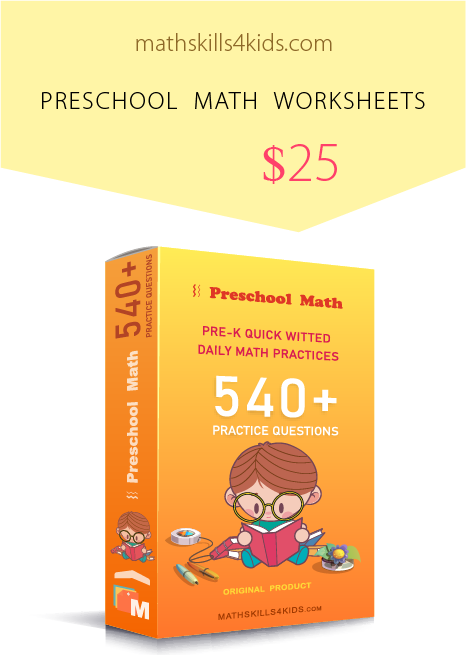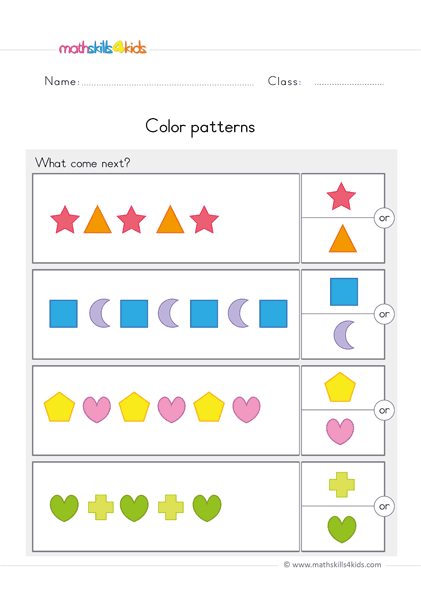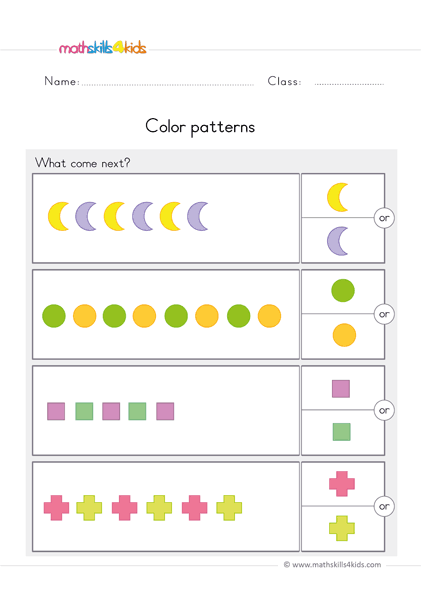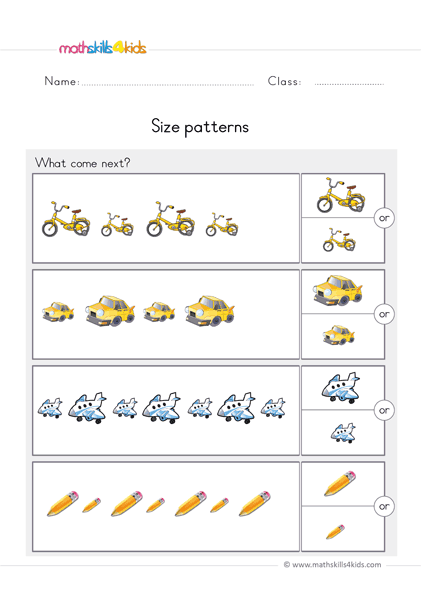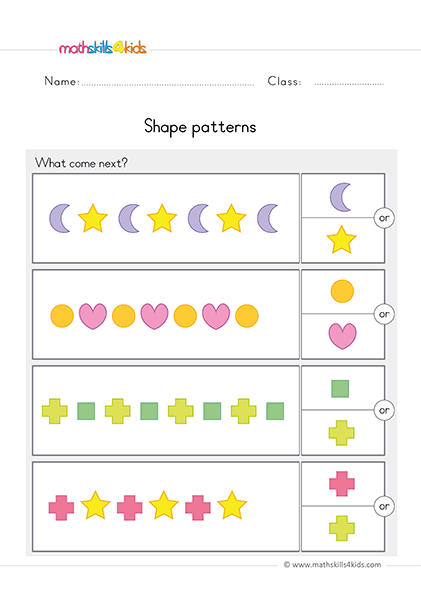Fun and easy pattern worksheets for preschool kids
Preschoolers love to learn and explore new ideas every day. Why not help them explore these super fun and easy pattern worksheets designed to provide preschool kids with cute designs on completing patterns?
Whether you're a parent, teacher, or caregiver, these worksheets are an excellent resource for keeping your little ones engaged and learning while having fun.
-
Patterns are all around us, from the stripes on a zebra to the tiles on a floor. Thus, understanding patterns is essential for young children to develop, as it helps them make sense of the world around them. Pattern recognition is also a key component of critical thinking and problem-solving, vital skills for success in school and beyond.
How to boost your child's math skills with pattern worksheets for preschool
Do you want to help your child develop their math skills in a fun and easy way? Pattern worksheet for preschool is perfect for uplifting and boosting your child's math skills!
Patterns are the foundation of many mathematical concepts, such as counting, sorting, and sequencing. By practicing patterns with colorful and engaging worksheets, your child will learn to recognize and create patterns and improve their logical thinking and problem-solving skills.
Besides, this resource consists of an answer guide that will help to solidify what they've learned and for you to assess their progress immediately. Plus, they will have a blast doing it! Here are some tips on how to use pattern worksheets for preschool to boost your child's math skills.
-
BROWSE THE WEBSITE
-
DOWNLOAD FREE WORKSHEETS
-
-
-
Introduction to Patterns
Before introducing patterns to kids, let's first find out what they consist of.
Patterns are sequences of objects, shapes, colors, numbers, or sounds that repeat in a logical order.
For example, a pattern can be red-blue-red-blue or circle-triangle-circle-triangle. Patterns can also be more complex, such as ABC-ABC-ABC or 123-456-123-456.
Everywhere we look, we can find patterns. Whether it's the stripes on a zebra or the tiles on a floor, patterns are a fundamental aspect of our surroundings.
For young children, comprehending these patterns is crucial as it aids them in making sense of the world they live in. Recognizing patterns is also a crucial part of critical thinking and problem-solving, both of which are essential skills for achieving success in school and beyond.
These fun and easy pattern worksheets are a great way to introduce preschoolers to the concept of patterns and help them develop these important skills.
-
Identifying Patterns
One of the first skills children need to learn about patterns is identifying them. Identifying patterns means finding the unit that repeats in a sequence and naming it.
These worksheets provide a variety of simple patterns for preschoolers to identify and complete. From basic AB patterns (such as red-blue-red-blue) to more complex ABB or ABC patterns, it offers a range of difficulty levels to challenge and engage young learners.
To help your child identify patterns, you can use pattern worksheets for preschool that show different sequences of objects or shapes and ask your child to find the unit that repeats. You can also point out patterns in your surroundings and ask your child to name them. For example, you can show your child a striped shirt and ask what colors repeat in the pattern.
-
Completing Patterns
Another skill that children need to learn about patterns is how to complete them. Completing patterns means finding the missing object or shape that follows the rule of the sequence. For example, the child may find in the pattern [ red-blue-red-? (unknown) ], that the missing color is the blue color.
To help your preschoolers enjoy practicing more of these completing patterns activities, use MathSkills4Kids.com pattern worksheets for preschool kids designed with incomplete sequences of objects or shapes and ask your child to fill in the blanks or circle the missing object among the available selection. You can also create your own patterns with toys, stickers, or crayons and ask your child to complete them.
Besides, these worksheets provide a variety of patterns for preschoolers to complete, from simple AB patterns to more complex ABB or ABC patterns. By practicing completing patterns, preschoolers will learn to identify and extend patterns, which will help them later in math and other subjects. Plus, completing patterns is a fun and engaging way to learn!
-
Creating Patterns
A more advanced skill that children need to learn about patterns is how to create them. Creating patterns is a great way to challenge preschoolers and help them develop their critical thinking skills. It means making your own sequences of objects or shapes that follow a rule.
For example, you can create a pattern with fruits like apple-banana-apple-banana or with letters like A-B-C-A-B-C.
To help your child create patterns, you can use pattern worksheets for preschool that have blank spaces for your child to draw or write their own patterns. You can also encourage your child to use their imagination and creativity to make their own patterns with different materials and media, like shapes, colors, and sizes.
You can also provide them with materials like beads, blocks, or stickers to create patterns. This will help them develop not only their creativity but also their problem-solving skills as they figure out how to create and extend their patterns.
-
Advanced Pattern Recognition
As your child becomes more confident and proficient with patterns, you can challenge them with more advanced pattern recognition activities. Advanced pattern recognition means finding the rule or logic behind a complex or irregular pattern. For example, you can ask your child what comes next in a pattern like 1-3-5-7-? or A-B-D-E-?.
To help your child develop advanced pattern recognition skills, you can use pattern worksheets for preschool with more challenging objects or shapes requiring higher-order thinking. You can also expose your child to different types of patterns, such as growing patterns (e.g., 1-2-4-8), shrinking patterns (e.g., 16-8-4-2), or alternating patterns (e.g., odd-even-odd-even).
These activities will help your child develop outstanding critical thinking and problem-solving skills.
Importance of patterns
Apart from being a fun and easy way to boost your kid's math skills, patterns are very important to a kid's math and mental development. Patterns help children make predictions, logical connections and enhance their reasoning skills as they begin to understand what comes next.
By using pattern worksheets for preschool and other activities, you can help your child learn how to identify, complete, create, and recognize patterns. You can also make pattern learning more engaging and enjoyable by using different materials and media and by pointing out patterns in your environment.
Useful links for more resources:
Free Preschool & Kindergarten Pattern Worksheets - Printable | K5 Learning
Browse Printable Preschool Shape Pattern Worksheets | Education.com
-
Thank you for sharing the links of MathSkills4Kids.com with your loved ones. Your choice is greatly appreciated.
I hope you found this content valuable and informative. Size comparison is a fun and easy way to teach your preschoolers math skills they will need in their future learning. Try these tips and tricks with your children and see how they enjoy creating arrangements of shapes and everyday objects in patterns.
Happy teaching!
